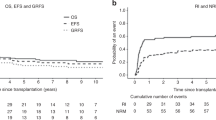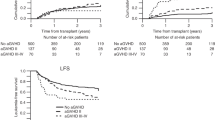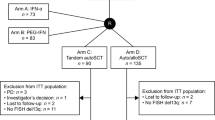Summary:
Conventional treatment or autologous transplantation has not been able to achieve long-term remission in patients with multiple myeloma (MM). Nonmyeloablative allogeneic transplantation might offer an option for cure without the high mortality associated with conventional conditioning. Here we present a retrospective analysis of patients with high-risk MM treated with nonmyeloablative allogeneic transplantation. In all, 52 patients with relapsed MM or high-risk features at diagnosis received 2 Gy TBI alone (n=3) or with fludarabine (n=49) as conditioning. Patients were heavily pretreated with a median of eight cycles of conventional chemotherapy and one or more autologous transplants for all but one patient. Regimen-related toxicity was low. Acute graft-versus-host disease II–IV occurred in 37% of patients, and 70% experienced chronic graft-versus-host disease (cGvHD). Median follow-up was 567 days, and transplant-related mortality was 17% in total. Estimated progression-free and overall survival at 18 months was 29.4 and 41.1%, respectively. Patients with cGvHD had a significantly higher progression-free survival, as did patients with up to eight cycles of pretreatment chemotherapy vs those with nine or more. In this highly pretreated patient group, disease control was unsatisfactory and our results suggest that a potential strategy might be to perform allogeneic transplant earlier in the course of the disease.
This is a preview of subscription content, access via your institution
Access options
Subscribe to this journal
Receive 12 print issues and online access
$259.00 per year
only $21.58 per issue
Buy this article
- Purchase on Springer Link
- Instant access to full article PDF
Prices may be subject to local taxes which are calculated during checkout





Similar content being viewed by others
References
Fermand JP, Ravaud P, Chevret S et al. High-dose therapy and autologous peripheral blood stem cell transplantation in multiple myeloma: up-front or rescue treatment? Results of a multicenter sequential randomized clinical trial. Blood 1998; 92: 3131–3136.
Attal M, Harousseau JL, Stoppa AM et al. A prospective randomized trial of autologous bone marrow transplantation and chemotherapy in multiple myeloma. N Engl J Med 1996; 335: 91–97.
Child JA, Morgan GJ, Davies FE et al. High-dose chemotherapy with hematopoietic stem-cell rescue for multiple myeloma. N Engl J Med 2003; 348: 1875–1883.
Barlogie B, Shaughnessy J, Tricot G et al. Treatment of multiple myeloma. Blood 2004; 103: 20–32.
Tosi P, Ronconi S, Zamagni E et al. Salvage therapy with thalidomide in multiple myeloma patients relapsing after autologous peripheral blood stem cell transplantation. Haematologica 2001; 86: 409–413.
Blade J, Esteve J . Treatment approaches for relapsing and refractory multiple myeloma. Acta Oncol 2000; 39: 843–847.
Moehler T, Neben K, Benner A et al. Salvage therapy for multiple myeloma with thalidomide and CED chemotherapy. Blood 2001; 98: 3846–3848.
Jagannath S, Barlogie B, Berenson J et al. A phase 2 study of two doses of bortezomib in relapsed or refractory myeloma. Br J Haematol 2004; 127: 165–172.
Turesson I, Abildgaard N, Ahlgren T et al. Prognostic evaluation in multiple myeloma: an analysis of the impact of new prognostic factors. Br J Haematol 1999; 106: 1005–1012.
Zojer N, Konigsberg R, Ackermann J et al. Deletion of 13q14 remains an independent adverse prognostic variable in multiple myeloma despite its frequent detection by interphase fluorescence in situ hybridization. Blood 2000; 95: 1925–1930.
Facon T, Avet-Loiseau H, Guillerm G et al. Chromosome 13 abnormalities identified by FISH analysis and serum β2-microglobulin produce a powerful myeloma staging system for patients receiving high dose therapy. Blood 2001; 97: 1566–1571.
Shaughnessy Jr J, Tian E, Sawyer J et al. Prognostic impact of cytogenetic and interphase fluorescence in situ hybridization-defined chromosome 13 deletion in multiple myeloma: early results of total therapy II. Br J Haemtol 2003; 120: 44–52.
Durie BG, Kyle RA, Belch A et al. Myeloma management guidelines: a common report from the Scientific Advisors of the International Myeloma Foundation. Hematol J 2003; 4: 379–398.
Bensinger WI, Maloney D, Storb R . Allogeneic hematopoietic cell transplantation for multiple myeloma. Semin Hematol 2001; 38: 243–249.
Tricot G, Vesole D, Jagannath S et al. Graft-versus-myeloma effect: proof of principle. Blood 1996; 87: 1196–1198.
Bertz H, Burger JA, Kunzmann R et al. Adoptive immunotherapy for relapsed multiple myeloma after allogeneic bone marrow transplantation (BMT): evidence for a graft versus myeloma effect. Leukemia 1997; 11: 281–283.
Lokhorst HM, Schattenberg A, Cornelissen JJ et al. Donor leukocyte infusions are effective in relapsed multiple myeloma after allogeneic bone marrow transplantation. Blood 1997; 90: 4206–4211.
Bjorkstrand B, Ljungman P, Svensson H et al. Allogeneic bone marrow transplantation vs autologous stem cell transplantation in multiple myeloma: a retrospective case-matched study from the European Group for Blood and Marrow Transplantation. Blood 1996; 88: 4711–4718.
Bensinger WI, Buckner CD, Anasetti C et al. Allogeneic marrow transplantation for multiple myeloma: an analysis of risk factors on outcome. Blood 1996; 88: 2787–2793.
Gharton G, Tura S, Ljungman P et al. Prognostic factors in allogeneic bone marrow transplantation for multiple myeloma. J Clin Oncol 1995; 13: 1312–1322.
Nagler A, Or R, Naparstek E et al. Second allogeneic transplantation using nonmyeloablative conditioning for patients who relapsed or developed secondary malignancies following autologous transplantation. Exp Hematol 2000; 28: 1096–1104.
Khouri IF, Keating M, Korbling M et al. Transplant-lite: induction of graft-versus-malignancy using fludarabine-based nonablative chemotherapy and allogeneic blood progenitor-cell transplantation as treatment for lymphoid malignancies. J Clin Oncol 1998; 16: 2817–2824.
Slavin S, Nagler A, Naparstek E et al. Nonmyeloablative stem cell transplantation and cell therapy as an alternative to conventional bone marrow transplantation with lethal cytoreduction for the treatment of nonmalignant hematologic diseases. Blood 1998; 91: 756–763.
Carella AM, Cavaliere M, Lerma E et al. Autografting followed by nonmyeloablative immunosuppressive chemotherapy and allogeneic peripheral-blood hematopoietic stem-cell transplantation as treatment of resistant Hodgkin's disease and non-Hodgkin's disease. J Clin Oncol 2000; 18: 3918–3924.
Mohty M, Fegueux N, Exbrayat C et al. Reduced intensity conditioning: enhanced graft-versus-tumor effect following dose-reduced conditioning and allogeneic transplantation for refractory lymphoid malignancies. Bone Marrow Transplant 2001; 28: 335–339.
Storb RF, Champlin R, Riddell SR et al. Non-myeloablative transplants for malignant disease. Hematology (Am Soc Hematol Educ Program) 2001, 375–391.
Badros A, Barlogie B, Morris C et al. High response rate in refractory and poor-risk multiple myeloma after allotransplantation using a nonmyeloablative conditioning regimen and donor leukocyte infusions. Blood 2001; 97: 2574–2579.
Kroger N, Schwerdtfeger R, Kiehl M et al. Autologous stem cell transplantation followed by a dose-reduced allograft induces high complete remission rate in multiple myeloma. Blood 2002; 100: 755–760.
Maloney DG, Molina AJ, Sahebi F et al. Allografting with non-myeloablative conditioning following cytoreductive autografts for the treatment of patients with multiple myeloma. Blood 2003; 102: 3447–3454.
Mohty M, Boiron JM, Damaj G et al. Graft-versus-myeloma effect following antithymocyte globulin-based reduced intensity conditioning allogeneic stem cell transplantation. Bone Marrow Transplant 2004; 34: 77–84.
Glucksberg H, Storb R, Fefer A et al. Clinical manifestations of graft versus host disease in human recipients of marrow from HLA matched sibling donors. Transplantation 1974; 18: 295–304.
Sullivan KM, Agura E, Anasetti C et al. Chronic graft-versus-host disease and other late complications of bone marrow transplantation. Semin Hematol 1991; 28: 250–259.
Blade J, Samson D, Reece D et al. Criteria for evaluating disease response and progression in patients with multiple myeloma treated by high-dose therapy and hematopoietic stem cell transplantation. Br J Haematol 1998; 102: 1115–1123.
Korn EL . Censoring distributions as a measure of follow-up in survival analysis. Stat Med 1986; 5: 255–260.
Kaplan EL, Meier P . Non-parametric estimation from incomplete observation. J Am Stat Assoc 1958; 47: 457–481.
Andersen P, Gill R . Cox's regression model for counting processes, a large sample study. Ann Statist 1982; 10: 1100–1120.
R Development Core Team. R: A Language and Environment for Statistical Computing. R Foundation for Statistical Computing: Vienna, Austria, 2004 (ISBN 3-900051-00-3).
Kroger N, Einsele H, Wolff D et al. Myeloablative intensified conditioning regimen with in vivo T-cell depletion (ATG) followed by allografting in patients with advanced multiple myeloma. A phase I/II study of the German Study-group Multiple Myeloma (DSMM). Bone Marrow Transplant 2003; 31: 973–979.
Kroger N, Sayer HG, Schwerdtfeger R et al. Unrelated stem cell transplantation in multiple myeloma after a reduced-intensity conditioning with pretransplantation antithymocyte globulin is highly effective with low transplantation-related mortality. Blood 2002; 100: 3919–3924.
Giralt S, Aleman A, Anagnostopoulos A et al. Fludarabine/melphalan conditioning for allogeneic transplantation in patients with multiple myeloma. Bone Marrow Transplant 2002; 30: 367–373.
Einsele H, Schaefer HJ, Hebart H et al. Follow-up of patients with progressive multiple myeloma undergoing allografts after reduced-intensity conditioning. Br J Haematol 2003; 121: 411–418.
Luft T, Moos M, Goldschmidt H et al. Dissociation of putative graft-versus-myeloma effects in patients with rapidly progressive multiple myeloma. Br J Haematol 2003; 123: 646–653.
Perez-Simon JA, Martino R, Alegre A et al. Chronic but not acute graft-versus-host disease improves outcome in multiple myeloma patients after non-myeloablative allogeneic transplantation. Br J Haematol 2003; 121: 104–108.
Kroger N, Perez-Simon J, Myint H et al. Influence of timing allogeneic stem cell transplantation after dose-reduced melphalan/fludarabine conditioning in multiple myeloma. Blood 2003; 102: 728a (abstr. 2694).
Acknowledgements
We thank P Stadtherr and I Opitz from the transplant coordination center, as well as the nurses and entire staff of the transplant unit. We also thank the patients and their families.
Author information
Authors and Affiliations
Corresponding author
Rights and permissions
About this article
Cite this article
Gerull, S., Goerner, M., Benner, A. et al. Long-term outcome of nonmyeloablative allogeneic transplantation in patients with high-risk multiple myeloma. Bone Marrow Transplant 36, 963–969 (2005). https://doi.org/10.1038/sj.bmt.1705161
Received:
Accepted:
Published:
Issue Date:
DOI: https://doi.org/10.1038/sj.bmt.1705161
Keywords
This article is cited by
-
Klinisches Update – Multiples Myelom
Der Radiologe (2022)
-
Multiples Myelom – bald heilbar?
Der Internist (2021)
-
Long-term outcome after allogeneic stem cell transplantation in multiple myeloma
Annals of Hematology (2021)
-
Primärtherapie beim Multiplen Myelom
Der Internist (2019)
-
Allogeneic transplantation in multiple myeloma: long-term follow-up and cytogenetic subgroup analysis
Leukemia (2019)



